新人教八年级下英语期末总复习
最新人教版英语八年级下册期末专项复习
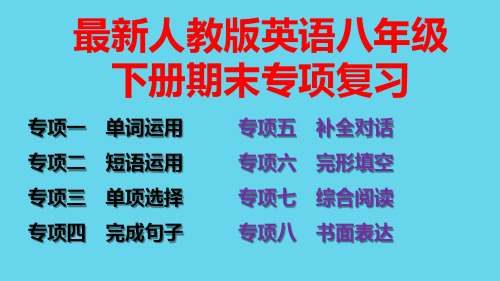
6. Boys, it’s ___u_n_f_a_ir_____ (fair) to let your mom do all the housework by herself; we should help her.
12. Russia has already _s_u_c_c_e_e_d_e_d_ (成功) in holding the 2018 World Cup.
13. It was really__u_n__b_e_li_e_v_a_b_le__ (难以置信的) that she argued with her mother.
人教版八年级下
专项二 短语运用
一 1 run out of 2 get on well with 3 come up with 4 cut out 5 get into
提示:点击 进入习题
答案呈现
6 tried out for
7 fallen asleep
8 making their way
9 To our surprise 10 cares for
saving animals. 3. Be careful of the ___b_r_o_k_e_n____ (break) glass, or it will hurt
you.
4. Tom has __d_i_f_fi_c_u_lt_y___ (difficult) in learning math. We should help him.
6 provide 7 Since 8 realized 9 usual 10 suddenly
人教八年级下册英语期末专项复习——词汇与句子(含答案)
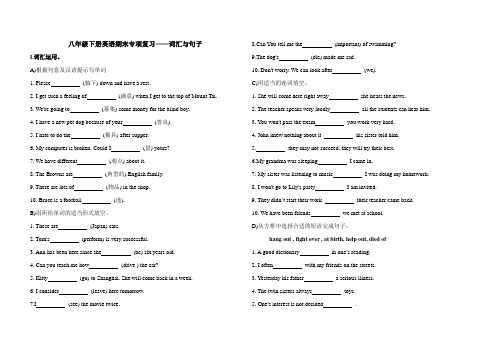
八年级下册英语期末专项复习——词汇与句子I.词汇运用。
A)根据句意及汉语提示写单词1. Please (躺下) down and have a rest.2. I get such a feeling of (满意) when I get to the top of Mount Tai.3. We're going to (募集) some money for the blind boy.4. I have a new pet dog because of your (善良).5. I hate to do the (餐具) after supper.6. My computer is broken. Could I (借) yours?7. We have different (观点) about it.8. The Browns are (典型的) English family.9. There are lots of (物品) in the shop.10. Bruce is a football (迷).B)用所给单词的适当形式填空。
1. These are (Japan) cars.2. Tom's (perform) is very successful.3. Ann has been here since she (be) six years old.4. Can you teach me how (drive ) the car?5. Kitty (go) to Shanghai. She will come back in a week.6. I consider (leave) here tomorrow.7.I (see) the movie twice. 8.Can You tell me the (important) of swimming?9.The dog's (die) made me sad.10. Don't worry. We can look after (we).C)用适当的连词填空。
八年级下人教版英语期末复习题 答案
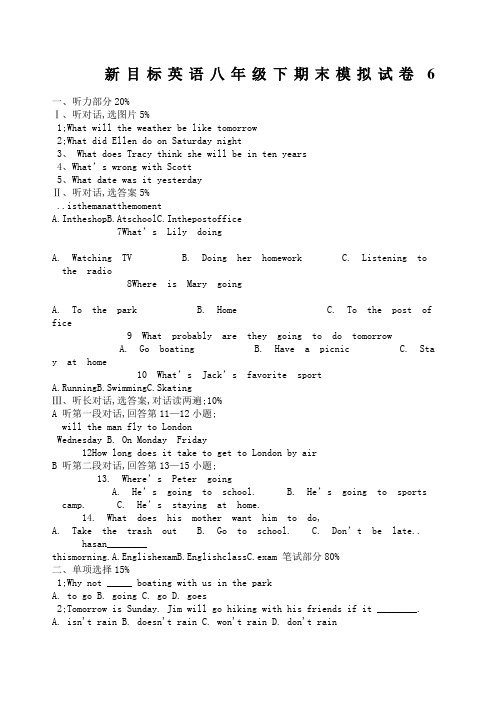
新目标英语八年级下期末模拟试卷6一、听力部分20%Ⅰ、听对话,选图片5%1;What will the weather be like tomorrow2;What did Ellen do on Saturday night3、 What does Tracy think she will be in ten years4、What’s wrong with Scott5、What date was it yesterdayⅡ、听对话,选答案5%..isthemanatthemomentA.IntheshopB.AtschoolC.Inthepostoffice7What’s Lily doingA. Watching TVB. Doing her homeworkC. Listening tothe radio8Where is Mary goingA. To the parkB. HomeC. To the post of fice9 What probably are they going to do tomorrowA. Go boatingB. Have a picnicC. Sta y at home10 What’s Jack’s favorite sportA.RunningB.SwimmingC.SkatingⅢ、听长对话,选答案,对话读两遍;10%A 听第一段对话,回答第11—12小题;will the man fly to LondonWednesday B. On Monday Friday12How long does it take to get to London by airB 听第二段对话,回答第13—15小题;13. Where’s Peter goingA. He’s going to school.B. He’s going to sportscamp. C. He’s staying at home.14. What does his mother want him to do,A. Take the trash outB. Go to school.C. Don’t be late..hasan________thismorning.A.EnglishexamB.EnglishclassC.exam 笔试部分80%二、单项选择15%1;Why not _____ boating with us in the parkA. to goB. goingC. goD. goes2;Tomorrow is Sunday. Jim will go hiking with his friends if it ________.A. isn't rainB. doesn't rainC. won't rainD. don't rain3;-Is he going to stay here long ---________.A. Yes, he willB. No, he won'tC. Yes, he isn'tD. No, he isn't4; I hope _______ a good job in a foreign company after I graduate ________ school.A. to find; fromB. finding; fromC. to find; atD. finding; at5;Howlonghaveyouhadthebike-__________.A.TwoyearsagoB.FortwoyearsagoC.Sincetw oyearsagoD.Sincetwoyears6;The radio is too loud. Will you please _______A. turn it downB. turn it onC. turn off itD. turn down it7. ---Lucy is doing her homework. -----Let’s ask Lily _______. A. but B. exceptC. insteadD. instead of8. If you work hard at your English, I’m sure you will _______ speak English very well next year.A. canB. able toC. be able toD. be able9 . -----Why don’t you like winter ---Because it’s _______ cold.A. notB. quietC. much tooD. too much10. _ I called you yesterday afternoon, but there was no reply.-----I ______ a dolphin show the zoo with my cousins.A. watchedB. will watchC. am watchingD. was watching11. When they went into the park, they saw someone ______ Chinese Kongfu.A. playsB. playedC. to playD. playing12.–Sorry,Ican’tgowithyou.Ihaveto______mylittlecousinA.takecareB.lookatC.baby sitD.babysitterabout _______ a scarfA. buyB. boughtC. buyingD. to buygirl _________ a tour guide since she left the school .A. have beenB. wasC. has beenD. isfriends have never heard of their names, ______ have I .A. soB. eitherC. neitherD. no16;. have been ______ English _______ ten years.A. study; forB. studying; sinceC. studying ; forD. to study; since17;. .Would you please wash the dishes. A. Yes, I would B. Yes, I’d like to C. Yes ,I ‘d like. D. Do please.18. May is a new student , ______________A. don’t sheB. doesn’t sheC. is sheD. isn’t she19. Have you ____ heard of DisneylandA. alwaysB. everC. neverD. often20. --_____ did you start studying English –Five years ago.A. WhenB. How longC. How oftenD. What三、完形填空10%Most of us have probably __1__of Mickey Mouse, Donald Duck, and many other famous Disney characters. Perhaps we have even seen them in movies. But have you ever__2_to Disneyland _3_fact, there are now four__4__Disneyland amusementparks around the world. Two are in the United States, one is in Japan, and__5_is in France.Disneyland is an amusement park, but we can __6__call it a theme park. It has all the normal___7___ that you can find at an amusement park, but it also has a theme. The theme, of course, is Disney movies and Disney characters. For example, you can find a roller coaster in most amusement parks, but in Disneyland, the roller coaster is __8__with Disney characters. This means that you can find Disney characters all over the roller coaster. You can also __9___Disney movies , eat in Disney restaurants, and buy Disney gifts. And you can see Disney characters __10___around Disneyland all the time.1. A. hear B. hears C. hearing D. heard2. A. been B. be C. gone D. go3. A. in B. on C. at D. to4. A. different B. difference C. same D. differences5. A. other B. the other C. others D. the others6. A. neither B. too C. either D also7. A. attract B. attracts C. attraction D. attractions8. A. theme B. themed C. themes D. theming9. A. watch B. saw C. read D. look10. A. walk B. walks C. walking D. walked四、阅读理解20%ASwimming is very popular in summer. People like swimming in summer because water makes them feel cool. If you swim in a wrong place, it may not be safe. These years, more than ten people died in this city while they were enjoying in the water and most of them were students. But some people are still not careful in swimming. They often think they swim so well that nothing can happen to them in water. Summer is here again. If you go swimming, don’t forget that better swimmers have died in water. They died because they were not careful, not because they were not good at swimming. So don’t get into water when you are alone. If there is a “No swimming” sign, don’t get into water, either. If you remember all this, swimming will be safer.判断正误;T表示正确;F表示错误B1. Swimming is a very safe sport.2. We shouldn’t swim in some wrong places.3. Only students died in water.4. If you are good at swimming, you will not died in water.5. If we often practice swimming, we will be safe.BExpert专家say that students usually need eight to ten hours’ sleep at night, but most Chinese students do not get enough sleep. Some Chinese parents are usually glad to see their children studying late. They will think their children work very hard, but not all parents are happy about this. Once a mother told us tat every morning her 10-year-old boy put up one finger 手指 with his eyes stillclosed, begging请求 for one more minute to sleep. Like thousands of students “ early birds” in China, he has to get up bef ore six every morning.A report shows that without a good night’s sleep, students seem to be weaker 虚弱 than they should be. Many students have fallen asleep during class at one time or another. Too much homework is not the only reason why students stay up late. Some watch TV or play the computer games late into the night. Experts have ever said that the students should develop good study habits. So some clever students never study last, they are able to work well in class.1. The 10-year-old boy begged for more minute to sleep because__________A. he didn’t have enough sleepB. it wasn’t time for him to get upC. he didn’t want to go to schoolD. he wanted his mother to wake him up2. In this passage we know if students don’t get enough sleep, they may________A. become too weak to sleepB. not work well in classC. go to bed earlyD. be weak in English3. In this passage “early birds” means “persons who ______________”A. get up earlyB. get up lateC. sleep lessD. don’t want to sleep4. “Stay up late” here means “_____________”A. study lateB. watch TV lateC. not go to bed until lateD. stay outside5. According to the passage, which of the following is right_________A. If you want to study better, you must work hard at night.B. Sleeping less means working hard.C. Some clever students are able to work well in class because they have good study habits.D. Students don’t have enough sleep because they have lots of homework to do. . 五、补全对话,从方框中选出适当的句子,完成对话;5%A. Have you made preparations做准备 for your lessonsB. I feel very sorry for you.C. the cause 原因of my failure.失败D. I failed in the examination.E. ask the teacher for advice.M: Why do you look unhappy these daysW: Because 1M: Are you serious 2W: I don’t care about the scores, but I haven’t found out 3, which has troubled me a lot.M: 4W: Yes, I spent the whole weekend on my lessons.M: You’d better 5六、单词拼写10%1. 1、One of the _____歌手 was very good .All of the people liked her.2. .I get ____生气 when classmates borrow my eraser and don't return it.3.There are _________ 数百 of people on the ground.4.Could you please give me some _________建议 for my study5. Would you mind ______清扫 the yard6.The children can look after _________他们自己.7; He doesn’t have enough money, ____________也8、Ten _____________ 参观者will visit our school.9.The students felt very __________ 疲劳的 after the long trip.10;The children ________跳舞 under the tree over there .Why not join them七.任务型阅读5%结合图示和所给句子内容,把句子前的字母代号填入图下面的括号内;5%1 23 4 5was a famous singer, he lived in wanted to visit Shichuan by plane.that day, the weather was very bad, it was raining.Allan decided to drive his car to Chendu.he went to Mountain was glad he saw a wonderful Bodhisattva 菩萨the way, he met many monkeys on the mountain.1、 2、3、 4、 5、八、书面表达10%根据内容提示,写一篇60-80字的短文;要求:内容表达完整,语句通顺,流畅,无语法错误;Actor wanted for an English playThe school movie club needs an actor. You will have chance to star in a popular school play. To get the job, please answer the three questions:1. How often do you watch movies2. How often you listen to English music3. How long do you learn EnglishAnd introduce yourself to us about your interests, hobbies and the things you are good at.假如你想参加这次演出,请根据表格中的信息,写一封电子邮件,介绍你的情况,包括兴趣爱好及能力,来应聘这项工作;期末测试一、听对话,选图片;5%1. M: Oh, what a rainy dayW: Yeah, but we really had good weather yesterday.M: Do you think it will be sunny tomorrowW: I hope so0. It is said that it will be sunny tomorrow.Q: What will the weather be like tomorrow: Hey, Ellen. Why didn’t you come to my house on Saturday nightW: Sorry, Bob. I went to a dancing party.M: Did you enjoy yourselfW: Yes.Q: What did Ellen do on Saturday night: Hi, Tracy. What are you doingW: I am practicing cooking. I will be a mother of a cute child in 10 years.M: What Are you kiddingW: No, I’m serious. I love children.Q: What does Tracy think she will be in ten years: I saw Scott crying in the corner. What happenedW: He hurt himself just now.Q: What’s wrong with Scott: What’s the date todayS2: It’s June 2Q: What date was it yesterday二、听对话,选答案5%6. W:Can I help you ,sirM:Yes,I don’t knowhowmu chIshouldpayforthisletter.W:Letmehavealook.Well,itonlycostsyou2dollars.7. M:LilySomeoneisknockingatthedoor,WouldyoupleaseopenitW:But,DadIhaveheardnothing.M:Turndownyourradio,andyouwillhear.8. W:Hi,JimMayIborrowyourbikeI’llgotopostaletter.M:Sure,Mary.ButwhereisyoursW:Mysisterhasittoday.9. M:ShallwegoboatingorhaveapicnictomorrowW:I’mafraidwecan’tgoanywherebecausetheradiosaiditwasgoingtoraintomorrow. M:Oh,badluck,Ihatestayingathome.:JackWhichseasondoyoulikebetter,springorautumnM:Autumn.ButsummerismyfavoriteseasonbecauseIcanswiminsummer.三、听长对话,选答案,对话读两遍;10%A听第一段对话,回答第11—12小题;hours B. Three hours and a half hoursme ,Is there any direct plane from here,There is one on Subday,Monday, Wednesday and Friday.M:When does it leave on WednesdayW:At 7:35in the morning.M:And when will it arriveW: At 10:35.M:Ok. Thanks.W: That’s OK.B听第二段对话,回答第13—15小题;W:Peter,canyouhelpmeforaminuteM:Yes,whatdoyouwantmetodo,MomW:WillyoutakethetrashoutM:DoIhavetodoitnowW:Well,youdon'thavetoitnow.Butdon'tforgettodoittoday.M:Allright.Ireallymustgonow;otherwiseI'llbelateforschool.W:Youhaveanexamthismorning,don'tyouYoumustn'tbelate.答案:◆听力部分1-5 AADCA 6-10 CCCCB 11-15 AAAAC◆笔试部分80%一、单项选择:1-5 CBDAC 6-10 ACCCA 11-15 DCCCC 16-20 CBDBA二、完形填空:1-5 DAAAB 6-10 DDBAC三、阅读理解:A1-5 FTFFF B1-5 ABACC四、补全对话,从方框中选出适当的句子,完成对话;1-5 DACBE五、单词拼写:1.Singers angry 3,hundreds 4. advice10. dancing六、任务型阅读:1-5CDABE。
人教新英语八年级下册期末综合复习卷(含答案)

人教版英语八年级下册期末综合复习卷(时间100分钟,满分120分)一、单项选择(每空1分,共25分)( ) 1. Alex is____ honest boy and he always volunteers to help ____disabled.A. a; aB. an; aC. a; theD. an; the( )2.—Don't ______ the rubbish everywhere!—Sorry,I won't.A.collect B.take C.dear D.throw( )3. My father was ____my plan. He thought it was not safe for a girl to travel alone.A. aboutB. withC. forD. against( )4.—Why do you like the book?—Because it ______ me of my childhood.A.reminds B.remembers C.returns D.introduces( )5. —Do you agree with me?—Sorry,I don't.In fact,I'm______your plan.A.for B.about C.with D.against( )6. —Could you help me clean the kitchen?—Sorry, I____. I am drawing now.A. couldn'tB. mustn'tC. can'tD. shouldn't( )7. The computer has made a great______to people's life.A.importance B.difference C.fairness D.decision( )8. Why not____ a robot(机器人)? It can give you more help.A. considerB. wonderC. regardD. provide( )9. —It's raining outside.We can't go out to play basketball on the playground.—We can watch a movie______.A.instead B.anymore C.yet D.either( )10. —You look very tired. What's wrong?—I watched an exciting football game______4 o'clock this morning.A. althoughB. unlessC. untilD. so that ( )11. He said he would visit his grandmother______ he came back. A.ever since B.so that C.as soon as D.even though( )12. Mrs.Brown asked Tony to help her______ the new books. A.try out B.go off C.hand out D.clean up( )13. —Have you ever ____Mount Huang?—Yes. I ____there last summer.A. gone to; goB. been to; wentC. gone to; wentD. been to; go ( )14. —Excuse me,can you repair the radio?—Sorry,I can't ______.It's too old.A.fix up them B.fix them up C.fix up it D.fix it up( )15. —Where was your mother when the rainstorm came yesterday?—She____ an email in the study.A. wroteB. will writeC. was writingD. is writing ( )16. Mr.Chen always encourages us ______ more books. A.reading B.to read C.read D.reads( )17. Jack used to ____ TV, but now he is used to ____ books.A. watch; readingB. watch; readC. watching; readD. watching; reading( )18. Li Qiang runs ______ than Wang Han.A.very fast B.much faster C.the faster D.fastest( )19. China has become the second ____economy in the world.And it has developed ____these days than before.A. larger; more quicklyB. largest; more quicklyC. larger; most quicklyD. largest; most quickly( )20. —______going to the cinema this afternoon?—Sounds great.A.Why don't you B.Could youC.How about D.Why not( )21. —How long have you ______ your hometown?—Since ten years ago.A.left B.been away fromC.come back to D.gone to( )22. —Could you please bring us something to drink?—________,tea or juice?A.Never mind B.Yes,sure C.It's up to you D.That's right( )23. —Why didn't you pick up my phone just now?—I ______ a shower when you called.A.take B.will take C.am taking D.was taking( )24. —Li Ming, could you please tell me how to order a taxi through “Didi”?—__________.A. It doesn't matterB. You're welcomeC. You're rightD. Sure, no problem( )25. —What's the matter with Jenny?—______.A.She is a shy girl B.She is a teacherC.She has a fever D.She likes painting二、完形填空(每空1分,共10分)One day a pastor's (牧师的)cat climbed up a tree and then was afraid to come down.The pastor tried his best,but nothing__26__.Later,the pastor decided that if he tied a rope (绳)with one end to the tree and the other end to his car and _27__away so that the tree would bend down(弯曲),he'd get the cat down.He did all the things.But when the __28__moved a little farther,the rope broke.The tree rebounded (反弹)so hard that the cat was out of his __29__.The pastor felt very sad.He walked around the city to look for his cat.However,nobody saw the small __30__.A few days later he met one of his church members in a store.He was __31__to see cat food in her shopping bag.This woman used to __32__cats.So he asked her,“What did you buy the cat food for?”She told him that her little daughter always expected a cat,but she kept__33__.Then a few days ago,the girl wanted it again,so she finally said,“Well,if God gives you a cat,I'll__34__.”“My child went out in the yard and asked God for a cat,” she went on.“And you won't believe this!A cat__35__ came down from the blue sky and landed right in front of her.”( )26.A.owned B.performed C.encouraged D.worked( )27.A.put B.gave C.took D.drove( )28.A.ship B.bike C.car D.train( )29.A.mind B.heart C.sight D.opinion( )30.A.house B.tree C.person D.animal( )31.A.excited B.pleased C.interested D.surprised( )32.A.love B.live C.hate D.feed( )33.A.refusing B.promising C.agreeing D.turning( )34.A.accept B.clear C.receive D.disagree( )35.A.deeply B.suddenly C.usually D.partly三、阅读理解(每题2分,共20分)ANowadays there are many people going from villages or small towns to big cities to realize their dreams, but there are also people doing the opposite.Janet Lincoln moved to St. Louis five years ago. Here's what she said:“I used to live in a small town called Bertrand. I grew up there. After I graduated (毕业) from high school, I worked in a supermarket. There were about 800 people in my town, and I knew most of them. Most of them knew me, too. At the age of 21, I got a chance (机会) and moved to St. Louis. I love it. I don't know as many people now as I used to, but that's OK. I live in an apartment and have a few good friends. There are a lot of fun things to do in the big city. ”Troy Henson has the opposite experience. He, his wife and their two children moved from St. Louis to Bloomfield three years ago. Here's what Troy said:“Both Darla and I grew up in St. Louis. We met at college and got married. Then the kids came along and life got difficult. We didn't know any of our neighbors. We both had good jobs, and we were always very busy. But it seemed there was never enough money. That all changed when we moved to Bloomfield. We don't make as much money as we used to, but we don't have as many expenses (开支) as we did and we are relaxed. It's good. ”()36. When Janet was in Bertrand, she______.A. made lots of moneyB. lived in an apartmentC. worked in a supermarketD. knew everyone in the town()37. Janet moved to St. Louis____.A. with her familyB. at the age of 21C. to help her friendsD. to get a better education()38. How many people are there in Troy's family?A. Three.B. Four.C. Five.D. Six.()39. According to Troy, living in Bloomfield is________.A. boringB. interestingC. tiringD. relaxing()40. In which part of a newspaper can we find this passage?A. Life.B. Health.C. Travel.D. Education.BWorld Sleep Day is on March 13 this year.How is your sleep these days?The CMDA(中国医师协会)asked 2,000 people in China about their sleep.About 36 percent of people often sleep badly.The study also finds that many students have only 5 hours of sleep a day.What cuts_into their sleeping time?The most important reason is homework.Also,some schools start early in the morning.But bad sleeping habits also play a role.Do you like to have a look at your mobile phone before going to bed?The survey finds that 60 percent of people check on their phones before they sleep.They read news,check their WeChat or talk with QQ friends.It's important for us to get enough sleep.If not,we'll feel tired and think slowly.And tired kids are often unhappy,too.We can't change our school time.But there are still ways to get better sleep.Stay away from Coke and coffee at night.They make it hard to fall asleep.Watch fewer TV series.Leave your mobile phone and computer on your desk.Then you will improve your sleep.And you will live a better and healthier life.( )41.How many people often sleep badly according to the CMDA?A.About 720. B.About 270.C.About 1,280. D.About 2,180.( )42.What's the most important reason why students don't have enough sleep?A.Too much homework. B.Talking with QQ friends.C.Bad sleeping habits. D.Drinking much Coke and coffee.( )43.What does the underlined part “cuts into” mean in Chinese?A.增加B.培养C.远离D.削减( )44.Which of the following is NOT true according to the passage?A.Many Chinese students sleep for 5 hours a day according to the survey.B.Bad sleeping habits can make us sleep badly and become unhappy.C.To get enough sleep,it's best to ask the school to change the time.D.Televisions,mobile phones and computers are bad for your sleep.( )45.In this passage,the writer is mainly trying to make the readers realize______.A.World Sleep Day is on March 13 this yearB.homework makes students have no enough time to sleepC.we feel tired and think slowly only because we have bad sleeping habits.D.good sleeping habits can help us stay healthy四、词汇运用(每题1分,共10分)A)根据句意及首字母提示填写单词。
新人教版八年级下英语期末复习资料
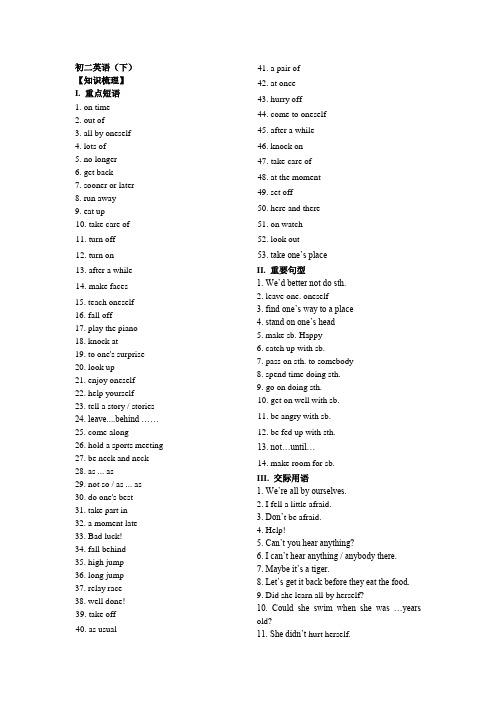
初二英语(下)【知识梳理】I. 重点短语1. on time2. out of3. all by oneself4. lots of5. no longer6. get back7. sooner or later8. run away9. eat up10. take care of11. turn off12. turn on13. after a while14. make faces15. teach oneself16. fall off17. play the piano18. knock at19. to one's surprise20. look up21. enjoy oneself22. help yourself23. tell a story / stories24. leave....behind ……25. come along26. hold a sports meeting27. be neck and neck28. as ... as29. not so / as ... as30. do one's best31. take part in32. a moment late33. Bad luck!34. fall behind35. high jump36. long jump37. relay race38. well done!39. take off40. as usual 41. a pair of42. at once43. hurry off44. come to oneself45. after a while46. knock on47. take care of48. at the moment49. set off50. here and there51. on watch52. look out53. take one’s placeII. 重要句型1. We’d better not do sth.2. leave one. oneself3. find one’s way to a place4. stand on one’s head5. make sb. Happy6. catch up with sb.7. pass on sth. to somebody8. spend time doing sth.9. go on doing sth.10. get on well with sb.11. be angry with sb.12. be fed up with sth.13. not…until…14. make room for sb.III. 交际用语1. We’re all by ourselves.2. I fell a little afraid.3. Don’t be afraid.4. Help!5. Can’t you hear anything?6. I can’t hear anything / anybody there.7. Maybe it’s a tiger.8. Let’s get it back before they eat the food.9. Did she learn all by herself?10. Could she swim when she was …years old?11. She didn’t hurt herself.12. He couldn’t buy himself many nice things.13. Did he enjoy himself?14. Help yourselves.15. Bad luck!16. Come on!17. Well done! Congratulations (to…)!18. It must be very interesting.19. I don’t think you’ll like it.20. It seems to be an interesting book.21. I’m sure (that)… I’m not sure if… I’m not sure what to…22. I hope so.23. What was he/she drawing when…?24. I’m sorry to trouble you.25. Would you please…?26. What were you doing at ten o’clock yesterday morning?27. You look tired today.28. You’d better go to bed early tonight, if you can.29. How kind!30. Let’s move the bag, or it may cause an accident.31. It’s really nice of you.32. Don’t mention it.33. Don’t crowd around him.IV. 重要语法1. 不定代词/副词的运用;2. 反身代词的用法;3. 并列句;4. 形容词和副词的比较等级;5. 冠词的用法;6. 动词的过去进行时;【名师讲解】1. bring/takeBring表示“带来、拿来”,指从别处朝说话人所在或将在的地方“带来、拿来”。
人教版八年级英语下册英语期末总复习试题
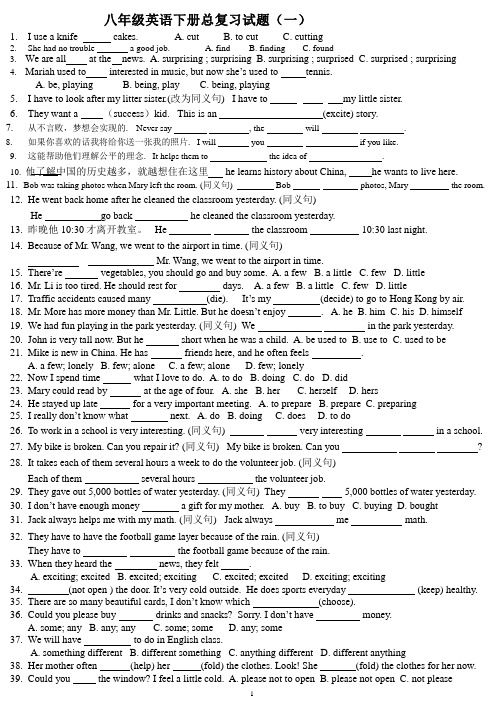
八年级英语下册总复习试题(一)1. I use a knife cakes. A. cut B. to cut C. cutting2. She had no trouble a good job. A. find B. finding C. found3. We are all_ at the news. A. surprising ; surprising B. surprising ; surprised C. surprised ; surprising4. Mariah used to interested in music, but now she’s used to tennis.A. be, playingB. being, playC. being, playing5. I have to look after my litter sister.(改为同义句) I have to my little sister.6. Th e y want a (success)k i d. Th i s i s an (excite) story.7. 从不言败,梦想会实现的. Never say , the will .8. 如果你喜欢的话我将给你送一张我的照片. I w ill you if you like.9. 这能帮助他们理解公平的理念. It helps them to the idea of .10. 他了解中国的历史越多,就越想住在这里h e lear ns h i s tor y about Ch i na, he wants to live here.11. Bob was taking photos when Mary left the room. (同义句) Bob photos, Mary the room.12. He went back home after he cleaned the classroom yesterday. (同义句)He go back he cleaned the classroom yesterday.13. 昨晚他10:30才离开教室。
初中英语 人教版八年级下册期末总复习(讲练+习题含答案,共104张PPT)

3. I think there will be more / less pollution. 我认为将会有更多/更少的污染。
fewer与less及more表数量的用法。
(3)many“许多”,修饰可数名词。 much“许多”,修饰不可数名词。
many / much比较级、最高级为不规则变化:many / much-more-most
“a few”表示“一些”+可数名词
例:a few days ago, for a few weeks, He has few friends here. There will be fewer trees.
3. I think there will be more / less pollution. 我认为将会有更多/更少的污染。
He went home after two days. 他两天后回家了。 Three years later,she had a baby. 三年后,她生了一个婴儿。
fall in love with 爱上… fall in love with a girl 爱上一个女孩 fall in love with a country 爱上一个国家
例:I have many magazines. She has more magazines. But he has the most. There will be more people on the earth in future. More and more students start to exercise more every day to keep fit.
典例展示 2.About Pollution
Tina: There is much pollution around us.
新人教版八年级下英语期末复习提纲
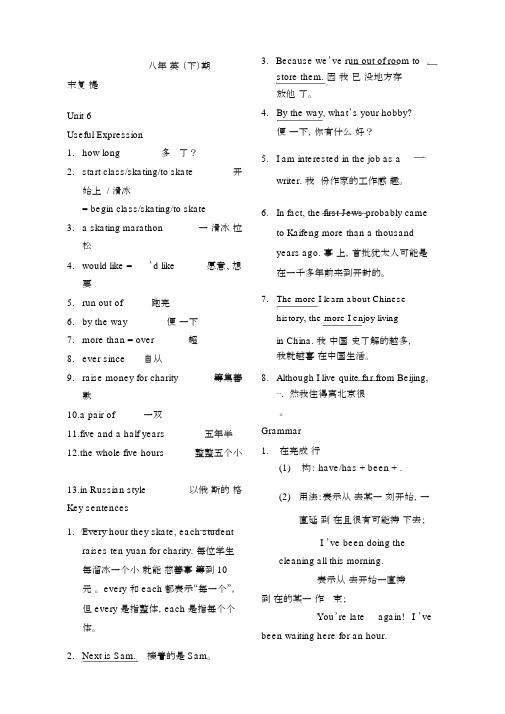
八年英(下)期末复提Unit 6Useful Expression1.how long多了?2.start class/skating/to skate开始上 / 滑冰= begin class/skating/to skate3. a skating marathon一滑冰拉松4.would like =’d like愿意、想要5.run out of跑完6.by the way便一下7.more than = over超8.ever since自从9.raise money for charity筹集善款10.a pair of一双11.five and a half years五年半12.the whole five hours整整五个小13.in Russian style以俄斯的格Key sentences1.Every hour they skate, each studentraises ten yuan for charity. 每位学生每溜冰一个小就能慈善事筹到 10元。
every 和 each 都表示“每一个”,但 every 是指整体,each 是指每个个体。
2.Next is Sam. 接着的是 Sam。
3. Because we’ve run out of room tostore them. 因我已没地方存放他了。
4.By the way, what’s your hobby?便一下,你有什么好?5.I am interested in the job as awriter. 我份作家的工作感趣。
6.In fact, the first Jews probably cameto Kaifeng more than a thousandyears ago. 事上,首批犹太人可能是在一千多年前来到开封的。
7.The more I learn about Chinesehistory, the more I enjoy livingin China. 我中国史了解的越多,我就越喜在中国生活。
人教新目标八年级英语下册期末复习——完成句子专练

新人教八下英语期末复习——完成句子专练1. 幸亏有你的帮助, 我们才按时完成了工作。
your help, we finished the work on time.2. 我坚信你会很快走出困境。
I’m sure that you can the difficult situation soon.3. 我想我以同样的姿势一动不动地坐得太久了。
I think I sat_________ ________ ________ ________ for too long without ________.4. 作为一名登山者,阿伦习惯于冒险。
As a mountain climber, Aron ________ ________ ________ ________ risks.5. 我想把我在动物医院工作的计划推迟到明年夏天。
I want to________ ________ my plan to work in an animal hospital ________ next summer.6. 谢谢你送给我一只这么可爱的宠物狗。
Thank you me such a cute pet dog.7. 网络使我们在家里购物成为可能。
The Internet for us to buy things at home.8. 帮助别人使我感到愉快。
me feel happy.9. 约翰常去看望养老院里的老人并使他们高兴起来。
John often goes the old people at the old peopl e’s home and.10. 我想把这些书捐赠给贫困山区的孩子们。
I’d like to these books to the children in the poor mountain areas.11. 这个周末我可以和朋友们一起去远足吗?go hiking with my friends this weekend?12. 每天早晨起床后, 我得整理床铺。
初二下册英语期末考试重点内容人教版

初二下册英语期末考试重点内容人教版【导语】学习作为一种获取知识交换情感的方式,已经成为人们日常生活中不可缺少的一项重要的内容,特别是在二十一世纪这个知识经济时期,自主学习已是人们不断满足自身需要、充实原有知识结构,获取有价值信息,并终究获得成功的宝贝。
以下是作者为大家准备的《初二下册英语期末考试重点内容人教版》,供您鉴戒。
1.初二下册英语期末考试重点内容人教版篇一1、 shouldshould是情态动词,意为“应当,应当”。
表示义务、责任,可用于各种人称,无人称和数的变化,也不能单独作谓语,只能和主要动词一起构成谓语,表示说话人的语气和情态;否定情势为should not,缩写为shouldn’t。
其主要用法有:(1)表示责任和义务,意为“应当”。
You should take your teacher’s advice.你应当听从你老师的建议。
You shouldn’t be late for class.你不应当上课迟到。
(2)表示推断,意为“可能,该”。
The train should have already left.火车可能已经离开了。
(3)当劝某人做或不做某事时,常用should do sth.或shouldn’t do sth.,比must和ought to更加委婉。
You should brush your teeth vefore you go to bed.你在睡觉前应当刷牙。
2、 need(1)need作实义动词,意为“需要,必定”,有人称、时态及数的变化。
sb./sth.需要某人/某物need+ to do sth.需要做某事doing需要(被)做He needs some help.他需要些帮助。
You didn’t need to come so early.你不必来这么早。
The s need watering.花需要浇水。
(2)need也可作情态动词,意为“需要,必须”,没有人称、数和时态的变化,后接动词原形,多用于否定句和疑问句中。
英语人教版八年级下册期末复习

(越来越漂亮)
2. The weather is gettingw__o_r_s_e__a_n_d__w__o_r_s_e_. (越来越槽糕)
3._T_h_e__m_o_r_e_c_a_r_e_f_u_lyou are, _t_h_e_f_e_w_e_r_mistakes you will make. (你越仔细,做错的题目就越少)
basketball players in NBA. (hot)
总结提高
1.表示三者或三者以上比较,可用”Which/Who … +最高级, …,…or …?”表示. Who is the tallest, Tom , Mike , or Jack?
2. 最高级+of/among (同类比较) in… (范围比较) Tom is the tallest of the three. Tom runs (the) fastest in our class.
A. goodest B. gooddest C. best D. better 3. This ruler is ____ than that one.
A. long B. longer C. the longest D. longest 4. This book is ____ of all.
A. cheapest B. cheap C. cheaper D. the cheapest 5. He is much ____ than his brother.
八年级(下)期末复习二
形容词、副词
的比较级和最高级
comparatives and superlatives with adj. and adv.
大多数形容词和副词有三个等级: 原级、比较级、最高级。
最新人教版英语八年级下册期末复习各单元知识点总复习
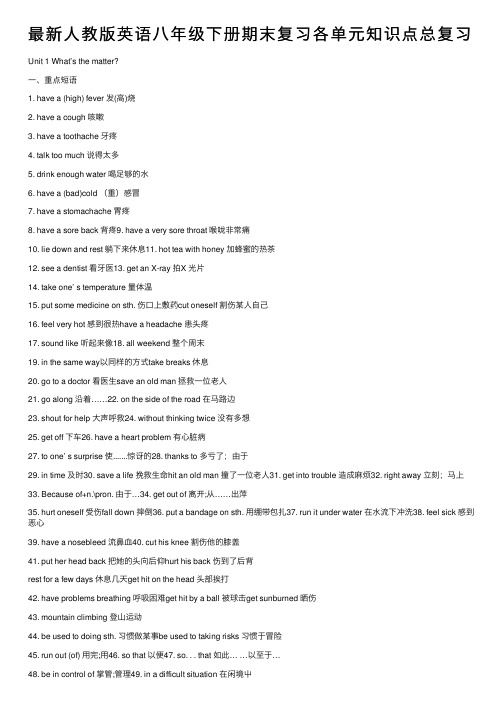
最新⼈教版英语⼋年级下册期末复习各单元知识点总复习Unit 1 What’s the matter?⼀、重点短语1. have a (high) fever 发(⾼)烧2. have a cough 咳嗽3. have a toothache ⽛疼4. talk too much 说得太多5. drink enough water 喝⾜够的⽔6. have a (bad)cold (重)感冒7. have a stomachache 胃疼8. have a sore back 背疼9. have a very sore throat 喉咙⾮常痛10. lie down and rest 躺下来休息11. hot tea with honey 加蜂蜜的热茶12. see a dentist 看⽛医13. get an X-ray 拍X 光⽚14. take one’ s temperature 量体温15. put some medicine on sth. 伤⼝上敷药cut oneself 割伤某⼈⾃⼰16. feel very hot 感到很热have a headache 患头疼17. sound like 听起来像18. all weekend 整个周末19. in the same way以同样的⽅式take breaks 休息20. go to a doctor 看医⽣save an old man 拯救⼀位⽼⼈21. go along 沿着……22. on the side of the road 在马路边23. shout for help ⼤声呼救24. without thinking twice 没有多想25. get off 下车26. have a heart problem 有⼼脏病27. to one’ s surprise 使.......惊讶的28. thanks to 多亏了;由于29. in time 及时30. save a life 挽救⽣命hit an old man 撞了⼀位⽼⼈31. get into trouble 造成⿇烦32. right away ⽴刻;马上33. Because of+n.\pron. 由于…34. get out of 离开;从……出萍35. hurt oneself 受伤fall down 摔倒36. put a bandage on sth. ⽤绷带包扎37. run it under water 在⽔流下冲洗38. feel sick 感到恶⼼39. have a nosebleed 流⿐⾎40. cut his knee 割伤他的膝盖41. put her head back 把她的头向后仰hurt his back 伤到了后背rest for a few days 休息⼏天get hit on the head 头部挨打42. have problems breathing 呼吸困难get hit by a ball 被球击get sunburned 晒伤43. mountain climbing 登⼭运动44. be used to doing sth. 习惯做某事be used to taking risks 习惯于冒险45. run out (of) ⽤完;⽤46. so that 以便47. so. . . that 如此… …以⾄于…48. be in control of 掌管;管理49. in a difficult situation 在闲境⼬lose one’s life 丧命cut off half his right arm 切除半边右臂bandage himself 给他⾃⼰包扎50. keep on doing sth. 继续或坚持做某事51. make a decision 做出决定the importance of making decision做决定的重要性52. take risks 冒险go mountain climbing 去爬⼭53. give up 放弃have a serious accident 遇到严重的意外54. talk about health problems谈论健康问题55. give advice 提建议⼆、重点句型1. What’ s the matter?What’ s the matter(with you)?= What’s the trouble (with you)?= What’ s wrong with you?你怎么了?I have a stomachache. 我肚⼦疼。
新人教版初中八年级下册英语期末专题复习(词汇专项训练)
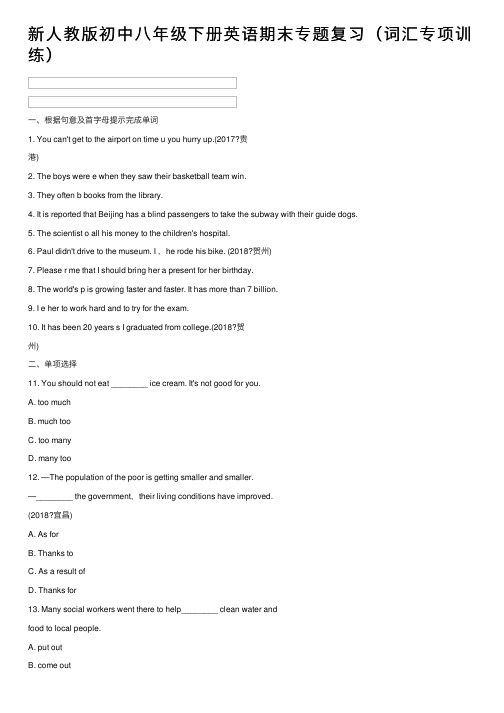
新⼈教版初中⼋年级下册英语期末专题复习(词汇专项训练)⼀、根据句意及⾸字母提⽰完成单词1. You can't get to the airport on time u you hurry up.(2017?贵港)2. The boys were e when they saw their basketball team win.3. They often b books from the library.4. It is reported that Beijing has a blind passengers to take the subway with their guide dogs.5. The scientist o all his money to the children's hospital.6. Paul didn't drive to the museum. I ,he rode his bike. (2018?贺州)7. Please r me that I should bring her a present for her birthday.8. The world's p is growing faster and faster. It has more than 7 billion.9. I e her to work hard and to try for the exam.10. It has been 20 years s I graduated from college.(2018?贺州)⼆、单项选择11. You should not eat ________ ice cream. It's not good for you.A. too muchB. much tooC. too manyD. many too12. —The population of the poor is getting smaller and smaller.—________ the government,their living conditions have improved.(2018?宜昌)A. As forB. Thanks toC. As a result ofD. Thanks for13. Many social workers went there to help________ clean water andfood to local people.A. put outD. give out14. Though he is________ at home, he doesn't feel ________,for he hasmany things to do.A. alone; lonelyB. lonely; aloneC. alone;loneD. lone; lonely15. The Internet is so closely connected with our daily life. Can you________ a life without it?A. understandB. imagineC. considerD. expect16. When you are swimming, ________ your ears. You can useearplugs(⽿塞) to stop water getting into your ears.A. take afterB. take part inC. take offD. take care of17. Mrs. Zhang is a famous actress. And she always speaks in a sweet________.A. musicB. noiseC. voiceD. song18. The ice and snow in Harbin is beautiful,so every winter________tourists come here. (2018?龙东)A. two million ofB. millions ofC. million of19. If we travel abroad,we prefer to stay in five-star hotels. That'sbecause they ________guests with the best service to make them feel at home. (2017?哈尔滨) A. preview20. —It's too late. I ________ that I may meet bad persons.—Don't worry. It is safe here.A. fearB. hideC. decideD. collect⼀、⽤所给单词的适当形式填空1. The little girl is so smart. She can make a cake by ________(she) without help. (2017?云南)2. I once asked him if he had any ________(difficult) in keeping fivechildren in school.3. I need ________ (silent) when I am studying. (2018?徐州)4. We all admire him because of his ________(kind) to every student.5. You are ________(fair), Mum. Why do you only want me to do chores?6. All the students had a discussion on language and ________ (communicate).7. The young man told the ________(true) while the policeman was questioning him.8. The couple have lived a happy life since they got ________(marry) 30 years ago.9. In ________(west) countries, people go to church at weekends.10. The baby pandas often die of ________(ill). They are hard to lookafter.⼆、单项选择11. Nancy took her temperature and found she had a ________.A. coughB. toothacheC. headacheD. fever12.Jimmy fixed up the old bikes and ________ to the poor.A. gave them awayB. gave it outC. gave out themD. gave up them13. The little boy ________ his seat to an old lady on the crowded bus.A. lent14. My father is going to New York by air tomorrow. He'll ________ next month.A. relaxB. comeC. returnD. arrive15. —I'm going to a job interview. I feel a little ________.—Take it easy. Some soft music can help you relax.A. nervousB. comfortableC. excitedD. happy16. —Don't smoke any more. It's bad for your health.—I'm trying to________. It's really hard, you know.A. turn it onB. put it offC. give it upD. take it out17. Xiongan New Area will help ________big problems in Beijing,such as traffic jams. (2017?济宁)A. set outB. check outC. work outD. give out18.—I think winter is a beautiful season,________ when it snows.—Me, too.A. luckilyB. especiallyC. probablyD. properly19. —________ have you talked with your friends on WeChat?—Since I finished my homework. (2018?莱芜)20. ________ the girls in my class have joined the music club.A. Three quarterB. Three quarter ofC. Three quartersD. Three quarters of⼀、根据句意及汉语提⽰完成单词1. There is a bookstore __________ (在……对⾯) our school. (2018?青岛)2. My mother doesn't like________(⽇本的)food.3. Tom began to show a special ________(兴趣)in painting in his childhood. (2018?⽇照)4. Do you know what the exact ________(⼈⼝) of China is? (2018?常州)5. We should do some things to________(保护)the environment.6. The river is over ten meters________(有……深的).7. Now the students are under too much________(压⼒). They have to study hard.8. You shouldn't________(借出)your books to others.9. About 10 passengers burned to________(死亡) in this traffic accident.10. He made a________ (决定)to go abroad after graduation. (2018?绥化)⼆、单项选择11. The girl can't see anything. She is ________.A. deafB. blindC. cleverD. lazy12. Scientists are trying their best to ________ ways to deal with theproblem.A. come up withB. look forward toC. talk aboutD. give up13. A robot show will be held in July,but________ knows the date forD. somebody14. Would you please ________ my baby brother while I'm cooking?A. take out ofB. take care ofC. take part inD. take after15. Students at Green High School often ________ books from their school library and can ________ them for a week.A. borrow; keepB. lend; keepC. borrow; borrowD. keep; borrow16. Parents should ________ a comfortable environment ________ their child.A. offer; withB. provide; forC. provide; toD. provide; with17. After I came back from shopping, I ________ I lost my wallet.A. watchedB. realizedC. hopedD. remembered18. Mr Black walked around and offered help________ we were doing an experiment. (2018?上海)A. whileB. althoughC. untilD. unless19. Don't give up. I believe you can ________ your dreams one day.A. riskD. accept20. ________,or we will not catch the train.A. Hurry upB. Be quietC. Be carefulD. Try out⼀、根据句意及⾸字母提⽰完成单词1. We should try our best to p the environment.2. There are lots of t visiting the Great Wall.3. The l in the room is poor, so I can't see anything clearly.4. They sat there in s .They didn't talk with each other.5. My bike is broken. Could you please l me yours?6. Don't p the door. Pull it, please.7. This desk is about 1.5 meters long and 0.7 meters w . (2017?海南)8. The old photo often r me of my happy time in middle school. (2017?黄⽯)9. N you nor John knows how to spell the word. (2017?荆门)10. Bob hasn't seen Kim s they graduated from high school.(2018?贵港)⼆、⽤所给单词的适当形式填空11. All of us heard the________ (laugh) from the house.12. Yesterday it snowed ________ (heavy) in the village.13. They stay at home instead of ________ (go) to the movies.14. My parents are________(German),but they need to live and work in England. (2017?黔南州)15. Junk food is bad for us, ________ (especial) for children.16. I'm feeling terrible. I have a ________ (stomach).17. I haven't seen them ________(recent). (2018?武威)18. —How much should I pay?—18 yuan in all,________ (include) the pen you picked out just now. (2018?常州)19. Last week the students went skating and enjoyed ________ (them) very much. (2017?上海)⼀、根据句意及汉语提⽰写单词1. Do you like ________(印度的) food? It's delicious.2. The photos bring back lots of good ________(回忆).3. The boy made up his mind to become an________ (优秀的) architect.4. ________ (⽆论什么) you say, I won't believe you any more.5. Goldilocks________(注意到) a little house,so she hurried towards it. (2017?聊城)6. China has been making many great ________(成就) in every field these years,which amazes the world. (2018?泰安)7. Mr Smith is sitting ________(在其中) a group of children,telling the story. (2017?贵港)8. They have decided to make use of the latest ________ (科技).9. The ________ (政府) is going to build a road through the mountains.10. The computer plays an important role in ________ (现代的) life.⼆、单项选择11. ________my surprise, Lily didn't go to Tom's birthday party.A. AtB. InC. ToD. With12. When your money________,please ask me for help.A. runs outB. is run out ofC. runs out ofD. was run out of13. —Whose bike is it?—It ________ to me. It's hers. (2017?天⽔)A. isn't belongedB. wasn't belongedC. didn't belongD. doesn't belong14. —Are you similar ________ your mother?—No. I take ________ my father.A. to; toB. after; afterC. after; to15. My bike is broken. I'll ________ tomorrow.A. fix up itB. fix it upC. put it upD. put up it16. The passage is too long. You should ________some sentences.A. cut outB. cut downC. cut inD. cut up17. —Driving after drinking always ________traffic accidents.—I agree. So we shouldn't drive after drinking.A. causesB. getsC. beginsD. ends18. Many foreigners came to our school last week,including three ________ and four________. (2018 ?凉⼭)A. German;AmericanB. Germans;AmericanC. Germans;AmericansD. German;Americans19. None of them talked. They finished their meal in ________.A. silenceB. orderC. placeD. public20. —Who ________ you here?—A policeman. We got lost and had to ask him for help.A. remindedB. foughtC. hidD. led1. He has lived in France for many years, but he can't speak Fwell.2. You must use some t to move the stone.3. In the desert, we can see s everywhere.4. Tom is such an h person that we all trust him. (2017?⽇照)5. Hard work is the key to s . (2017?⽇照)6. Watching too much TV is a w of time.7. Mr. Smith is getting married this Sunday and his w is a doctor.8. The students are singing here to r money for charity(慈善).9. I want to buy a new c to take some photos.10. The b policeman saved the boy from the burning building.⼆、根据汉语意思完成句⼦11. 26路公共汽车正⾏驶在中华路上,这时司机看到⼀位⽼⼈正躺在路边。
八年级英语人教版(新目标)(最新版)下学期期末复习一
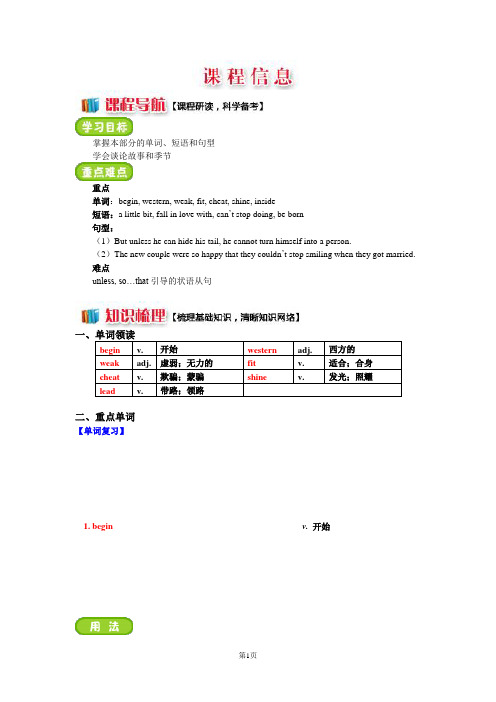
掌握本部分的单词、短语和句型学会谈论故事和季节重点单词:begin, western, weak, fit, cheat, shine, inside短语:a little bit, fall in love with, can’t stop doing, be born句型:(1)But unless he can hide his tail, he cannot turn himself into a person.(2)The new couple were so happy that they couldn’t stop smiling when they got married.难点u nless, so…that引导的状语从句begin v. 开始western adj. 西方的weak adj. 虚弱;无力的fit v. 适合;合身cheat v. 欺骗;蒙骗shine v. 发光;照耀lead v. 带路;领路二、重点单词【单词复习】1. begin v. 开始其过去式为began。
后面跟名词、动名词或动词不定式,接动名词和不定式无意义区别。
同义词是start。
When did he begin learning English? =When did he begin to learn English?他什么时候开始学英语的?begin with 以……开始beginning n. 开始,可构成短语:at the beginning of 在……之初Let’s begin the meeting with a happy song.让我们以一首欢快的歌曲开始会议。
At the beginning of this term, we made plans to study hard.在这学期之初,我们就制定了计划要努力学习。
My mother ____________ cooking half an hour ago.A. startsB. startingC. beginsD. began答案:D思路分析:根据half an hour ago可知时态用一般过去时。
人教版八年级下册英语期末复习:Unit 1-Unit 10 各单元重点语法知识点汇编(全面!)

人教版八年级下册英语期末复习:Unit 1-Unit 10各单元重点语法知识点汇编Unti1 what’s the matter?一、四会单词Matter, stomachache, foo, neck, stomach,throat, fever, toothache , headache, break, passenger,trouble, knee, nosebleed, climber, accident,situation, blood, importance, decision, spirit,death, nurse,lie, hurt,hit,press,breathe,mean,herself,ourselves,sore,sick, sunburned,cough, bandage, risk , control二、重点词组与句子1.too much 太多2.lie down 躺下3.get an X-ray 做个X光检查4.take one ’s temperature 量体温5.put some medicine on ......在....上敷药6.have a fever 发烧7.take breaks /take a break 休息8.without thinking twice 没多想9.get off 下车10.take sb to the hospital 送某人去医院11.wait for等待12.to one’s surprise 使.......惊讶的13.thanks to多亏于;由于14.in time及时15.think about 考虑16.have a heart problem患有心脏病17.get into the trouble 遇到麻烦18.do the right thing做正确的事情事情19.fall down 摔倒20.put ...... on sth把...放在某物上21.get hit/sunburned 摔伤/烧伤22.be interested in 对.....感兴趣23.be used to 习惯于.... 24.take risks/take a risk 挑战25.lose one’s life 失去生命26.because of 因为27.run out of 用完28.cut off 切除29.get out of 从...出来30.make a decision/decisions 做决定31.be in control of 掌管;管理32.give up 放弃重点句子:1.She talked about too much and didn’t drink enough water.She has a very sore throat.2.You need to take breaks away from the computer.3.I think I sat in the same way for too long without moving.4.The driver saw an old man lying on the side of the road,a woman next to him was shouting for help.5.He expected most of or all of the passengers to get off and wait for the next bus.6.Thanks to him and the passengers,the mas was saved by doctors in time.7.It’s sad that many people don’t want to help others because they don’t want any trouble.8.The driver didn’t think about himself,he only thought about saving a life.9.There were many times when Aron almost lost his life because of accidents.10.Because he could not free his arm,he stayed there for five days and hoped that someone would find him.11.When his water ran out,he knew that he would have to do something to save his own life.12.Let’s think about it before we find ourselves “between a rock and a hard place”,and before we have to make a decision that could mean life or death.重点搭配:1.need to do sth .需要去做某事2.see sb doing sth 看见某人正在做某事3.ask sb sth 询问某人某事4.expect sb to do sth 期望某人做某事5.agree to do sth 同意做某事6.help sb (to) do sth 帮助某人做某事7.want to do sth 想要做某事8.tell sb to do sth 告诉某人做某事9.have problems(in) doing sth 做某事有困难e sth to do sth用某物去做某事11.be/get used to doing sth 习惯于做某事12.seem to do sth 好像做某事13.keep on doing sth 继续做某事14.mind doing sth 介意做某事语法点1.询问某人的健康问题及遇到麻烦的表达方法2.情态动词should的用法3.不定代词的用法精细解读1. What’s the matter (with you)? 怎么了?出什么事了?What’s the trouble/ the problem / wrong with sb./ sth.?2. I had a cold.我感冒了。
人教版八年级下册英语期末总复习(1)
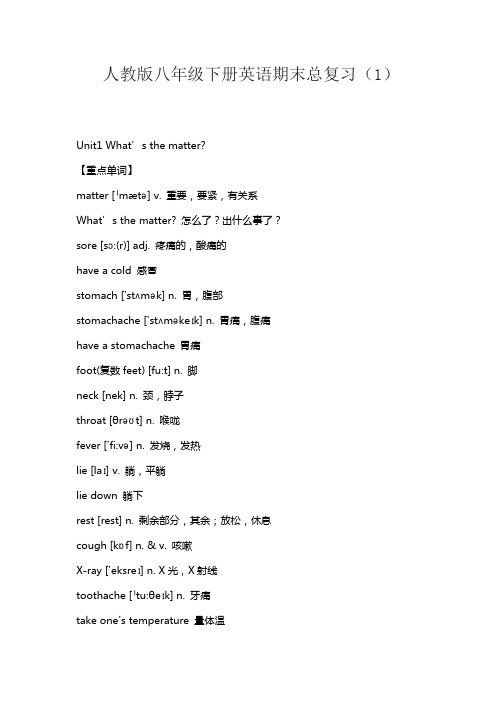
人教版八年级下册英语期末总复习(1)Unit1 What’s the matter?【重点单词】matter [ˈmætə] v. 重要,要紧,有关系What’s the matter? 怎么了?出什么事了?sore [sɔ:(r)] adj. 疼痛的,酸痛的have a cold 感冒stomach ['stʌmək] n. 胃,腹部stomachache ['stʌməkeɪk] n. 胃痛,腹痛have a stomachache 胃痛foot(复数feet) [fu:t] n. 脚neck [nek] n. 颈,脖子throat [θrəʊt] n. 喉咙fever ['fi:və] n. 发烧,发热lie [laɪ] v. 躺,平躺lie down 躺下rest [rest] n. 剩余部分,其余;放松,休息cough [kɒf] n. & v. 咳嗽X-ray ['eksreɪ] n. X光,X射线toothache [ˈtu:θeɪk] n. 牙痛take one's temperature 量体温headache [ˈhedeɪk] n. 头痛have a fever 发烧break [breɪk] n. & v. 休息,暂停;打破take breaks (take a break)休息hurt [hə:t] v. 伤害,损害,使受伤passenger ['pæsɪndʒə] n. 乘客,旅客off [ɒf] adv. prep. 离开(某处);从…去掉get off 下车to one's surprise 使…惊讶,出乎…意料onto [ˈɒntə] prep. 向,朝trouble [ˈtrʌbl] n. 麻烦,烦扰,问题hit [hit] n. & v. 碰撞,打,打击right away 立即,马上get into 陷入,参与herself [hə:ˈself] pron. 她自己,她本身(she的反身代词)bandage ['bændɪdʒ] n. & v. 绷带;用绷带包扎sick [sɪk] adj. 患病的,不适的knee [ni:] n. 膝盖nosebleed [ˈnəʊzbli:d] n. 鼻出血breathe [bri:ð] v. 呼吸sunburned [ˈsʌnbɜ:nd] adj. 晒伤的ourselves [ɑ:ˈselvz] pron. 我们自己(we的反身代词)climber [ˈklaɪmə(r)] n. 登山者be used to 习惯于…适应于…risk [rɪsk] n. & v. 风险,危险;冒险take risks (take a risk) 冒险accident [ˈæksidənt] n. 意外事件;事故situation [ˌsitjuˈeiʃən] n. 状况,形式,情况kg=kilogram [ˈkɪləg ræm] n. 公斤,千克rock [rɔk] n. 岩石run out (of) 用尽,耗尽knife [naif] n. 刀,餐刀cut off 切除blood [blʌd] n. 血mean [mi:n] v. 意味着,意思是,意欲get out of 离开,从…出来importance [ɪmˈpɔ:tns] n. 重要性decision [dɪ'sɪʒn] n. 决心,决定,抉择control [kən'trəʊl] v. 控制,支配,操纵be in control of 掌管,管理spirit ['spɪrɪt] n. 勇气,意志death [deθ] n. 死亡give up 放弃nurse [nə:s] n. 护士【重点短语】1.have a fever 发烧2.have a cough 咳嗽3.have a toothache 牙疼4.talk too much 说得太多5.drink enough water 喝足够的水6.have a cold 受凉;感冒7.have a stomachache 胃疼8.have a sore back 背疼9.have a sore throat 喉咙痛10. take risks 冒险11.hot tea with honey 加蜂蜜的热茶12.see a dentist 看牙医13.get an X-ray 拍X 光片14.take one’s temperature 量体温15.put some medicine on sth. 在……上面敷药16. give up 放弃17. sound like 听起来像18. all weekend 整个周末19. in the same way 以同样的方式20. go to a doctor 看医生21. go along 沿着……走22. on the side of the road 在马路边23. shout for help 大声呼救24. without thinking twice 没有多想25. get off 下车26. have a heart problem 有心脏病27. to one’s surprise 另某人惊讶的是28. thanks to 多亏了;由于29. in time 及时30. make a decision 做出决定31. get into trouble 造成麻烦32. right away 立刻;马上33. because of 由于34. get out of 离开;从……出来35. keep on doing sth. 继续或坚持做某事36. put a bandage on sth. 用绷带包扎37. fall down 摔倒38. feel sick 感到恶心39. have a nosebleed 流鼻血40. cut his knee 割伤他的膝盖41. put her head back 把她的头向后仰42. have problems breathing 呼吸困难43. mountain climbing 登山运动44. be used to doing sth. 习惯做某事45. run out (of) 用完;用尽46. so that 以便47. so...that... 如此……以至于...…48. be in control of 掌管;管理49. in a difficult situation 在闲境中【重点句型】1. What's the matter with you?= What'the trouble with you?= What's wrong with you? 你怎么了?2. What should she do? 她该怎么办呢?3.Should I take my temperature? 我应该量一下体温吗?4.You should lie down and rest. 你应该躺下休息一会儿。
- 1、下载文档前请自行甄别文档内容的完整性,平台不提供额外的编辑、内容补充、找答案等附加服务。
- 2、"仅部分预览"的文档,不可在线预览部分如存在完整性等问题,可反馈申请退款(可完整预览的文档不适用该条件!)。
- 3、如文档侵犯您的权益,请联系客服反馈,我们会尽快为您处理(人工客服工作时间:9:00-18:30)。
八年级下时态总结:过去进行时1.过去进行时的构成过去进行时由was/were+doing构成2.过去进行时的用法1)表示过去某一时刻或过去一段时间内正在进行的动作。
常和表示过去的时间状语then,at that time,this time yesterday,at ten yesterday等连用,或用另一动作来表示过去的时间。
如:--What were you doing at nine last night?--I was watching TV at that time.He was reading when I came in.I was doing my homework while my parents were watching TV.2)过去进行时常和always等表频率的副词连用,表示过去频繁发生的习惯性动作,此时的过去进行时带有一定的感情色彩。
如:Alice was always changing her mind.3.一般过去时和过去进行时的区别一般来说,如果强调过去某个时候或某段时间曾有过某个(已完成的)动作时应用一般过去时;而如果强调动作在过去某个时候或某段时间内正在进行(是否完成不明确)时则用过去进行时。
练习:Part 1 用所给动词的正确形式填空。
1.–What _____ you ______(do) at that time?--We __________(watch) TV.2. I _________(have) my breakfast at half past six yesterday.3. While we __________(wait) for the bus, a girl ________(run) up to us.4. I ___________(telephone) a friend when Bob ________(come) in.5. --_________ they ________(have) a meeting at 4 yesterday afternoon?--No, they ___________. They ________(clean) the classroom.现在完成时1.定义:表示现在动作已发生或状态已存在或过去的动作状态持续到现在,一般翻译成“已经”,“….过”3.用法:1.表示过去已经发生但对现在情况有影响的动作,常与already, never, up to now, in thelast…years, yet(多用于否定句), just, before等词连用。
He has gone to Beijing. (表示他不在这里。
)2.表示过去开始,持续到现在的动作或状态,常与since, for等连用。
We have not seen each other for ten years. (没见面的动作从十年前持续到现在。
)3.表示到现在为止,动作发生的状况,如:次数等。
I’ve been to Shanghai three times.辨析:Already: 多用于肯定句中,在用于疑问句中时,表示疑惑,惊讶或出乎意料。
Just:表示“刚”,一般放在谓语动词之前,表示刚刚完成的动作。
Since:意为“自…以来”,后可接表示起点时间的单词,也可接一个时间状语从句,多用于完成时态。
Since表示持续到现在,用于完成时;after只表示在某一时刻之后,用于过去时。
只有在It is … since这样的句子结构中,主句的谓语才可用一般现在时,一般过去时或现在完成时。
It is ten years since I saw you last time.现在完成时还可以与“包括现在在内的”表示一段时间的状语连用,表示到说话时动作仍未结束。
如:today, this morning (afternoon, evening, week, month, year..), these days等。
表示非延续性动作的动词不能与表示一段时间的状语连用。
常见的这类动词有:appear, begin, borrow, buy, close, die, fall, find, finish, join, kill, leave, lend, lose, sell, start, stop等。
have been to、have gone to 和have been in的区别1)have been to “去过某地”,强调说话以前的动作发生过或延续到现在2)have gone to “已去某地”, 强调人已经离开,不在说话现场。
3)have been in “已在某地(待了多久)”, 若该地方为小地方,则用at代替in,若后面是there,here等时间副词,则have been后面不需要介词现在完成时练习:1. How long have you _______ here?A. comeB. gotC. arrivedD. been2. My grandpa died _________.A. at the age of my 2B. for 2 yearsC. when I was 2.D. my age was 6.3. Jane has _____ to Beijing. She will come back tomorrow.A. beenB. goneC. wentD. never been4. It is ten years _____ I last saw her.A. afterB. sinceC. forD. that5.--Who will go to the station to meet Lorry?--I will. I _____ her several times.A. metB. have metC. had metD. will meet6. --What a nice dress! How long _____ you _____ it?--Just 2 weeks.A. will, buyB. did, buyC. are, havingD. have, had7.--Do you know Lydia very well?--Yes, She and I _____ friends since we were very young.A. have madeB. have becomeC. have beenD. have turned8. The Smiths _______ in China for 8 years.A. has livedB. livedC. have beenD. live9. --Hello, this is Mr. Green speaking. Can I speak to Mr. Black?-- Sorry. He ______ the Bainiao Park.A. has been toB. has gone toC. went toD. will go to10. --____ you ever ____ to the US?-- Yes, twice.A. Have, goneB. Have, been C, Do, go D. were, going主将从现如果从句是由__if___ (如果),____when__ (当),____as soon as______ (一…就…) 引导的一般现在时的条件状语从句,主句要用一般将来时或用can, should等情态动词组成的句子。
If it rains tomorrow, I will stay at home.When he grows up , he will be a doctor.As soon as I call him, he will pick me up.注意:宾语从句中的if与条件状语从句if的区别。
宾语从句中的if“是否”相当于whether,宾语从句通常位于主句之后。
引导宾语从句,时态需根据语境确定I don't know if it_______ (rain)tomorrow.练习:I __________ (see) this movie, and I __________ it last night.I ____________ (sleep) when the telephone __________ (ring) yesterday.If you __________ (go) to the party, you ___________ a good time.They ____________________ (watch) TV since 10 o’ clock. Look, they are still ______________ (watch) TV now.She ____________ (meet) Jay twice, and tomorrow she ______________ (meet) him again八年级下重点语法、句型直接引语与间接引语----宾语从句直接引语变间接引语的变化形式1.人称代词和指示代词的变化指示代词this 和these通常变为that和those 。
人称代词也要根据情况做适当调整。
从句中的第一人称多变为第三人称,第二人称根据情况改为第一人称或第三人称,第三人称不变。
例如:He said, “I came to help you.” 他说:“我是来帮助你的。
”→He said that he had come to help me. 他说他是来帮助我的。
2.时态的变化(1)引述动词如果用一般现在时或一般将来时,间接引语的时态不变。
(2)引述动词如果用一般过去时,间接引语的时态要变成相应的过去时态的一种。
具体变化如下:一般现在时→一般过去时一般过去时→过去完成时一般将来时→过去将来时现在进行时→过去进行时现在完成时→过去完成时(1)含有情态动词的直接引语变成间接引语是,情态动词也要相应地变成过去时态。
(2)若直接引语为客观真理或自然规律,变为间接引语时,时态不变。
(3)有时由于直接引语有特定的过去时间状语,变为间接引语时,时态不变。
3.时间状语的变化now → then last month → the month beforetoday → that day three days ago → three days beforetonight → that night tomorrow → the next daythis week → that week next month → the next monthyesterday → the day before the day after tomorrow → in two days4.地点状语的变化here → there5.谓语动词的变化come → go直接引语变为间接引语的情况1.直接引语为陈述句(1)将直接引语变为由that 引导的宾语从句,接在谓语动词之后(that 可以省略)。
